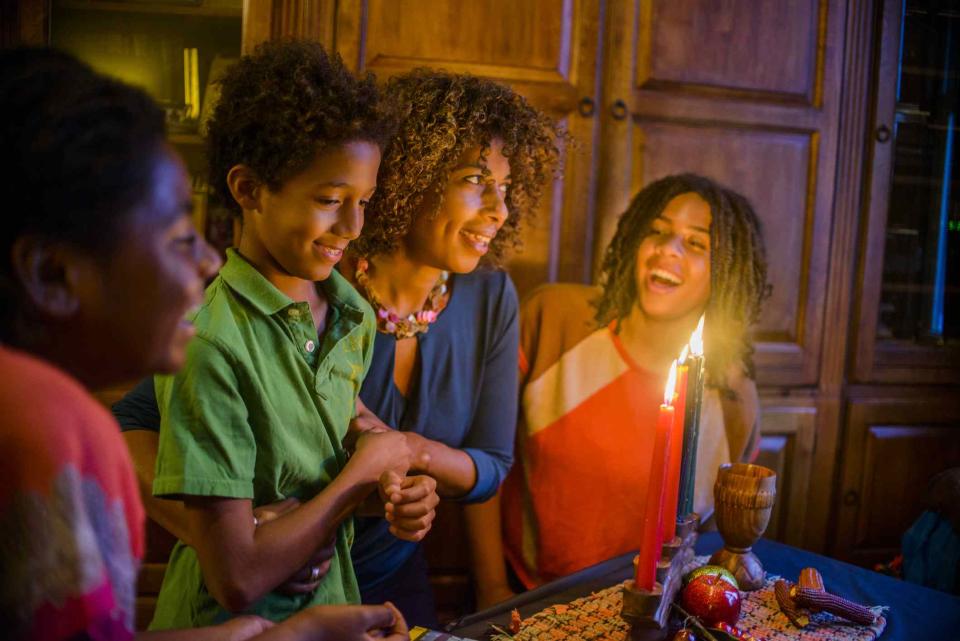Celebrating Kwanzaa Helped My Son Grow Up
From Umoja to Imani, the principles of Kwanzaa reflect my family values and helped me raise my Black son.

Sue Barr/Getty Images
I remember the holidays fondly when my son was in elementary school. The house would be abuzz with Motown Christmas classics as we sipped hot cocoa and decorated the tree. Back then, he was part of a village of Black boys who attended the same independent school. It was truly kismet for our only child to find a circle of boys who would become like brothers. And just like brothers, they often spent seven days a week together playing on sports teams, carpooling, and during breaks, vacationing together.
I was also blessed to find mom friends Charlie and Nefertiti who shared the same desire I did to instill in our boys a sense of cultural pride and unity. In addition to fun Black History Month presentations, we began a tradition of family Kwanzaa gatherings. Celebrated from December 26th until January 1, the purpose of Kwanzaa is to “bring a cultural message that speaks to the best of what it means to be African and human in the fullest sense,” according to the official Kwanzaa website. Rather than centering on prayer and religious traditions like Christmas and Hanukah, Kwanzaa’s focus is on African-American culture, community, and family. And, now, I can reminisce and see the direct influence those gatherings had on the person my son is today.
Our goal with the celebrations was intentional—to start a tradition the kids would remember for years and hopefully pass down to their own families someday. Each child selected one of the seven Kwanzaa principles—Umoja (Unity), Kujichagulia (Self-Determination), Ujima (Collective Work and Responsibility), Ujamaa (Cooperative Economics), Nia (Purpose), Kuumba (Creativity), and Imani (Faith) – and created a fun presentation at a festive party where each family contributed a dish. We fellowshipped, ate, drank, and settled in for the highlight of the evening—the presentations. Some of the kids donned African attire, others wore the Kwanzaa colors of red, black, and green. When our son was young, my husband and I helped him research his principle, taught him the meaning of it, and explained to him how we could apply it to our lives in the new year. It was heartwarming (and sometimes comical) as we encouraged the kids as they displayed their scribblings. Those scribbles were seeds that grew into powerful directives that helped our children grow.
One year, he selected the fourth principle, Ujamaa (Cooperative Economics), which means "to build and maintain our own stores, shops, and other businesses and to profit from them together." We committed to buying products from as many Black-owned businesses as possible. Over the years the presentations evolved, as did his ability to take initiative in researching and modeling the principles himself.
In middle school, he selected the third principle, Ujima (Collective Work and Responsibility), which instructs us to build and maintain our community together and make our brother’s and sister’s problems our problems and solve them together. Our son learned more than the power of community that year. He also learned practical skills on how to communicate his message and blew us away with a PowerPoint presentation that featured music, graphics, and a follow-up Q&A session. He pledged to be an ally to his friends and presented them with a 52-week money challenge.
That was an especially fun year because he learned the value of saving. It was also an example of how the things he learned on his Kwanzaa journey also benefited our household by challenging my husband and me to be more money-conscious, too.
My son and the other children in our community learned many other lessons through our annual gatherings. There was a year that a family shared highlights from their sojourn to Ghana that had the kids riveted. That event inspired a love for travel and an appreciation for Africa. Our son learned lessons about the importance of faith in community. The gatherings always culminated in a prayer circle for a safe and prosperous new year led by one of the fathers.
Lastly, our son is learning to continue the traditions with loved ones, even through uncertainty, through our celebrations. When the pandemic hit, we were determined to keep the tradition alive and pivoted to a Kwanzaa Zoom celebration with music, Kahoot games, and shorter presentations that left everyone still feeling connected.
My son towers over me now. The young men in his crew are all thriving in different high schools which makes it difficult to coordinate schedules and get together. Still, I know the celebrations of past years have given my son something invaluable. As we pulled the decorations out this year, I was surprised when he mentioned how much he missed our Kwanzaa parties. When I asked why he expressed his enjoyment in learning so much about our people and our culture, it was a full-circle moment and an emotional one as I realized the intention we set out to instill was a great and lasting success.
For more Parents news, make sure to sign up for our newsletter!
Read the original article on Parents.

